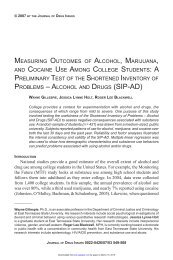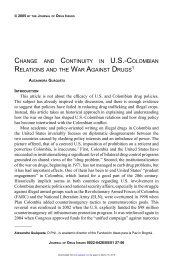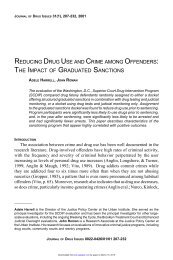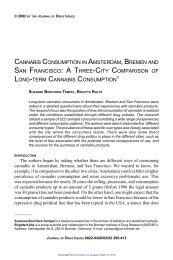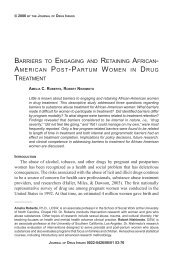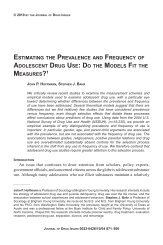a framework to examine gateway relations in drug use
a framework to examine gateway relations in drug use
a framework to examine gateway relations in drug use
Create successful ePaper yourself
Turn your PDF publications into a flip-book with our unique Google optimized e-Paper software.
© 2010 BY THE JOURNAL OF DRUG ISSUESA FRAMEWORK TO EXAMINE GATEWAY RELATIONS INDRUG USE: AN APPLICATION OF LATENT TRANSITIONANALYSISMILDRED M. MALDONADO-MOLINA, STEPHANIE T. LANZAA progressive and hierarchical sequence of <strong>drug</strong> <strong>use</strong> suggests that a sequenceof stages of <strong>drug</strong> <strong>use</strong> can describe the order by which adolescents try <strong>drug</strong>s.We propose an operational defi nition <strong>to</strong> test <strong>gateway</strong> <strong>relations</strong> by provid<strong>in</strong>g a<strong>framework</strong> with the aim of describ<strong>in</strong>g a set of conditions <strong>to</strong> guide the evaluationof whether a <strong>drug</strong> serves as a <strong>gateway</strong> for another <strong>drug</strong>. We <strong>use</strong>d data fromthe National Longitud<strong>in</strong>al Study of Adolescent Health <strong>to</strong> demonstrate how us<strong>in</strong>glatent transition analysis we can estimate the odds of us<strong>in</strong>g a <strong>drug</strong> at a later timeconditional on hav<strong>in</strong>g <strong>use</strong>d a <strong>gateway</strong> <strong>drug</strong> at an earlier time. We provide threeempirical demonstrations for test<strong>in</strong>g the <strong>gateway</strong> <strong>relations</strong> us<strong>in</strong>g a national andlongitud<strong>in</strong>al data of adolescents (e.g., <strong>gateway</strong> relation between cigarettes andmarijuana, alcohol and marijuana, and alcohol and cigarettes).INTRODUCTIONDespite slight decreases <strong>in</strong> alcohol and <strong>to</strong>bacco <strong>use</strong> <strong>in</strong> recent years, alcohol and<strong>to</strong>bacco <strong>use</strong> cont<strong>in</strong>ues <strong>to</strong> be a significant public health concern among adolescents(Johns<strong>to</strong>n, O’Malley, Bachman, & Schulenberg, 2009). Accord<strong>in</strong>g <strong>to</strong> the Moni<strong>to</strong>r<strong>in</strong>gthe Future Study, 58.3% of tenth graders have tried alcohol, 31.7% have tried<strong>to</strong>bacco, and 29.9% have tried marijuana (Johns<strong>to</strong>n et al., 2009). Similarly, accord<strong>in</strong>g<strong>to</strong> the Youth Behavior Risk Survey, 74.7% of high school students have ever triedalcohol, 48.8% have tried cigarettes, and 36.9% marijuana (Ea<strong>to</strong>n et al., 2008).__________Dr. Mildred M. Maldonado-Mol<strong>in</strong>a is Assistant Professor <strong>in</strong> the Department of Epidemiology andHealth Policy Research and the Institute for Child Health Policy at the University of Florida. Herresearch foc<strong>use</strong>s on health disparities of alcohol and substance <strong>use</strong>, del<strong>in</strong>quency behaviors, andeffects of public policies <strong>to</strong> reduce disparities <strong>in</strong> alcohol-related consequences. Dr. Stephanie T. Lanzais Scientific Direc<strong>to</strong>r of The Methodology Center at Penn State. She currently leads a research teamfoc<strong>use</strong>d on advanc<strong>in</strong>g latent class analysis and related methods. Her latest book, with L<strong>in</strong>da Coll<strong>in</strong>s,Ph.D., is Latent Class and Latent Transition Analysis: With Applications <strong>in</strong> the Social, Behavioral, andHealth Sciences (2010) Wiley.JOURNAL OF DRUG ISSUES 0022-0426/10/04 901–924Downloaded from jod.sagepub.com by guest on March 15, 2015
MALDONADO-MOLINA, LANZALiterature concern<strong>in</strong>g the etiology of <strong>drug</strong> <strong>use</strong> among youth suggests that legal<strong>drug</strong>s (e.g., alcohol and <strong>to</strong>bacco) serve as <strong>gateway</strong> <strong>drug</strong>s for illicit <strong>drug</strong> <strong>use</strong>. The<strong>gateway</strong> hypothesis of <strong>drug</strong> <strong>use</strong> has been def<strong>in</strong>ed as the notion of a progressive andhierarchical sequence of stages of <strong>drug</strong> <strong>use</strong>, suggest<strong>in</strong>g an ordered progression of<strong>drug</strong> <strong>use</strong> <strong>in</strong>volvement (Kandel, 1975; Kandel, 2002; Kandel, Yamaguchi, & Cous<strong>in</strong>oKle<strong>in</strong>, 2006). Accord<strong>in</strong>g <strong>to</strong> this hypothesis, <strong>drug</strong> <strong>use</strong> <strong>in</strong>volvement can be describedby a sequence depict<strong>in</strong>g the order by which adolescents try <strong>drug</strong>s; and the mostcommon sequence starts with legal <strong>drug</strong>s (either alcohol or cigarettes), which arebelieved <strong>to</strong> <strong>in</strong>crease the risk for try<strong>in</strong>g illegal and harder <strong>drug</strong>s, such as marijuana,coca<strong>in</strong>e, and hero<strong>in</strong>.Kandel provided the first attempt <strong>to</strong> systematically review what was known aboutthe <strong>gateway</strong> hypothesis (Kandel, 2002). Specifically, Kandel and Jessor (2002) <strong>use</strong>dthree <strong>in</strong>terrelated propositions <strong>to</strong> summarize current knowledge on the <strong>gateway</strong>hypothesis (Kandel & Jessor, 2002). First, the sequenc<strong>in</strong>g proposition suggests that<strong>drug</strong> <strong>use</strong> <strong>in</strong>volvement <strong>in</strong>cludes “try<strong>in</strong>g different classes or categories of <strong>drug</strong>s <strong>in</strong>an ordered fashion” (Kandel & Jessor, 2002, p. 365). Empirical evidence suggeststhat the <strong>drug</strong> <strong>use</strong> sequence typically starts with alcohol or cigarettes, followed bydrunkenness, marijuana, and harder <strong>drug</strong>s (Coll<strong>in</strong>s, 2002; Fergusson, Boden, &Horwood, 2006; Hawk<strong>in</strong>s, Hill, Guo, & Batt<strong>in</strong>-Pearson, 2002; Kandel, 2002; Kandel& Yamaguchi, 2002). Second, the association proposition suggests that the “<strong>use</strong>of certa<strong>in</strong> <strong>drug</strong>s is associated with <strong>in</strong>creased risk for other more advanced <strong>drug</strong>s”(p. 366). Etiological, prevention and <strong>in</strong>tervention studies have provided strongsupport for this proposition; therefore, many prevention efforts have targeted thereduction of <strong>in</strong>itiation of <strong>gateway</strong> <strong>drug</strong>s based on the association proposition byargu<strong>in</strong>g that prevent<strong>in</strong>g <strong>in</strong>itiation of legal <strong>drug</strong>s reduces the likelihood of <strong>in</strong>itiationof other illegal <strong>drug</strong>s (Botv<strong>in</strong>, Griff<strong>in</strong>, Diaz, & Ifil-Williams, 2001; Bretteville-Jensen, Melberg, & Jones, 2008; Cleveland & Wiebe, 2008; Degenhardt et al.,2009; Fergusson, et al., 2006; Lessem et al., 2006; Mart<strong>in</strong>, 2003; Rebellon & VanGundy, 2006; Wagner & Anthony, 2001).A gap <strong>in</strong> the literature is that although the term <strong>gateway</strong> hypothesis is well known,there is no widespread agreement about exactly how <strong>to</strong> operationalize the <strong>gateway</strong>hypothesis applied <strong>to</strong> the study of <strong>drug</strong> <strong>use</strong> <strong>in</strong>volvement among adolescents. Inthe current study, we <strong>in</strong>tegrate the <strong>framework</strong>s of Kandel and Jessor (2002) andColl<strong>in</strong>s (2002) <strong>to</strong> provide an operational def<strong>in</strong>ition of the <strong>gateway</strong> hypothesis thatwill allow the exam<strong>in</strong>ation of whether or not a <strong>gateway</strong> relation exists between two<strong>drug</strong>s us<strong>in</strong>g empirical data. We develop this <strong>framework</strong> with the aim of describ<strong>in</strong>g aset of conditions <strong>to</strong> guide the evaluation of whether a <strong>drug</strong> serves as a <strong>gateway</strong> foranother <strong>drug</strong>. In sum, the present study will (1) propose an operational def<strong>in</strong>ition of902 JOURNAL OF DRUG ISSUESDownloaded from jod.sagepub.com by guest on March 15, 2015
LTA AND GATEWAY RELATIONSthe <strong>gateway</strong> hypothesis for the progression of <strong>drug</strong> <strong>use</strong>, and (2) demonstrate its <strong>use</strong><strong>in</strong> a longitud<strong>in</strong>al study of adolescent <strong>drug</strong> <strong>use</strong> onset us<strong>in</strong>g latent transition analysis.AN OPERATIONALIZATION OF THE GATEWAY HYPOTHESISKandel and Jessor (2002) provided a schema for organiz<strong>in</strong>g the literature onthe <strong>gateway</strong> hypothesis. In the current study, we <strong>in</strong>tegrate the first two propositionssuggested by Kandel & Jessor (2002) (i.e., sequenc<strong>in</strong>g and association proposition)with the methodological operationalization of the <strong>gateway</strong> hypothesis as outl<strong>in</strong>edby Coll<strong>in</strong>s (2002). Coll<strong>in</strong>s (2002) called for an explicit probability-based def<strong>in</strong>itionof the <strong>gateway</strong> hypothesis us<strong>in</strong>g latent transition analysis <strong>to</strong> estimate the relevantprobabilities. She argued that there is a <strong>gateway</strong> relation between <strong>drug</strong> A and <strong>drug</strong>B if:1. There is a clear order whereby <strong>drug</strong> A is tried before <strong>drug</strong> B.2. The probability of try<strong>in</strong>g <strong>drug</strong> B is greater for those who have tried <strong>drug</strong> Awhen compared <strong>to</strong> those who have not tried <strong>drug</strong> A.The first condition established an order <strong>in</strong> which the <strong>drug</strong>s are tried, an important,but not sufficient condition for a <strong>gateway</strong> relation between two <strong>drug</strong>s. The secondcondition tested whether <strong>use</strong> of one <strong>drug</strong> is associated with <strong>in</strong>creased risk for <strong>use</strong>of the other <strong>drug</strong>. Accord<strong>in</strong>g <strong>to</strong> this def<strong>in</strong>ition, both of these conditions must be met<strong>in</strong> order for a <strong>gateway</strong> relation <strong>to</strong> exist between <strong>drug</strong>s.In the current study, we propose an operational def<strong>in</strong>ition of the <strong>gateway</strong>hypothesis that like Coll<strong>in</strong>s (2002) is probability-based, and foc<strong>use</strong>s on the riskfor us<strong>in</strong>g <strong>drug</strong> B at a later time (conditional on <strong>use</strong> of a <strong>gateway</strong> <strong>drug</strong> at an earliertime). There is no <strong>gateway</strong> relation if: <strong>drug</strong> A precedes the <strong>use</strong> of <strong>drug</strong> B, but <strong>use</strong> of<strong>drug</strong> A at an earlier time does not <strong>in</strong>crease the risk for <strong>use</strong> of <strong>drug</strong> B at a later time(i.e., odds equal <strong>to</strong> 1). To evaluate whether one <strong>drug</strong> <strong>in</strong>creases the risk for another<strong>drug</strong>, we <strong>use</strong> latent transition analysis (LTA) <strong>to</strong> a longitud<strong>in</strong>al model of <strong>drug</strong> <strong>use</strong><strong>in</strong> order <strong>to</strong> estimate the odds of us<strong>in</strong>g <strong>drug</strong> B after hav<strong>in</strong>g tried <strong>drug</strong> A. In the nextsection of this manuscript, we (a) describe LTA (as a statistical <strong>to</strong>ol <strong>to</strong> test <strong>gateway</strong><strong>relations</strong>) and (b) <strong>in</strong>troduce three empirical demonstrations for test<strong>in</strong>g the <strong>gateway</strong><strong>relations</strong> us<strong>in</strong>g a national sample data of adolescents from a longitud<strong>in</strong>al study. Inthe first example, we test for a <strong>gateway</strong> relation between cigarettes and marijuana;the second tests for a <strong>gateway</strong> relation between alcohol and marijuana; and the thirdtests for a <strong>gateway</strong> relation between alcohol and cigarettes.METHODSPARTICIPANTSTo illustrate how <strong>to</strong> test for <strong>gateway</strong> <strong>relations</strong> us<strong>in</strong>g longitud<strong>in</strong>al data, we <strong>use</strong>ddata from the National Longitud<strong>in</strong>al Study of Adolescent Health (Add Health; Harris,2009). We <strong>use</strong>d data from one cohort of adolescents <strong>in</strong> tenth (n=2019) grade whoFALL 2010903Downloaded from jod.sagepub.com by guest on March 15, 2015
MALDONADO-MOLINA, LANZAwere first <strong>in</strong>terviewed between April and December 1995; and the same subjects were<strong>in</strong>terviewed aga<strong>in</strong> between April and August 1996. We <strong>in</strong>cluded data from wave 1and wave 2 beca<strong>use</strong> it captures the adolescence developmental period <strong>in</strong> which the<strong>in</strong>itiation of <strong>drug</strong>s typically occurs; recent data from Add Health <strong>in</strong>cluded measuresamong young adults. For the current study, adolescents were age 15.7 years old(sd=.46) at wave 1 (53.7% females and 46.3% males). Youth were predom<strong>in</strong>antlyWhite (72.2%); and other ethnic groups were also <strong>in</strong>cluded (16.8% AfricanAmerican/Black and 13.6% self-identified as Lat<strong>in</strong>o/Hispanic ethnic background).MEASURESTo measure an <strong>in</strong>dividual’s level of <strong>drug</strong> <strong>use</strong>, five items were <strong>use</strong>d at each wave.Table 1 reports the frequency distribution and percentage of <strong>drug</strong> <strong>use</strong> at each time.Responses on these items were coded “never <strong>use</strong>d” and <strong>use</strong>d “once or more.” Threeitems were <strong>use</strong>d <strong>to</strong> measure alcohol and drunkenness at each time. Alcohol <strong>use</strong> wasassessed with one item: Dur<strong>in</strong>g the past 12 months, on how many days did youdr<strong>in</strong>k alcohol? Drunkenness were measured with two additional items: Over thepast 12 months, on how many days did you dr<strong>in</strong>k five or more dr<strong>in</strong>ks <strong>in</strong> a row? andOver the past 12 months, on how many days have you gotten drunk or ‘very, veryhigh’ on alcohol? One item was <strong>use</strong>d <strong>to</strong> measure cigarette smok<strong>in</strong>g at each wave:Dur<strong>in</strong>g the past 30 days, on how many days did you smoke cigarettes? One itemwas <strong>use</strong>d <strong>to</strong> measure marijuana at each wave: Dur<strong>in</strong>g the past 30 days, how manytimes did you <strong>use</strong> marijuana? In the Add Health study, the time frame for report<strong>in</strong>gcigarette and marijuana <strong>use</strong> was the last 30 days, whereas alcohol and drunkennesswere assessed dur<strong>in</strong>g the last 12 months. The <strong>use</strong> of other illicit <strong>drug</strong>s (i.e., recent<strong>use</strong> of coca<strong>in</strong>e) was not <strong>in</strong>cluded beca<strong>use</strong> of very low sample size (n=24 at time 1and n=18 at time 2).ANALYTICAL STRATEGYTo evaluate whether a <strong>gateway</strong> relation existed between two <strong>drug</strong>s, threeanalytical steps were followed:1. Fit a latent transition model.2. Identify population at risk.3. Calculate the odds ratio (OR) <strong>to</strong> evaluate <strong>gateway</strong> <strong>relations</strong>.This procedure was followed <strong>to</strong> <strong>exam<strong>in</strong>e</strong> the <strong>gateway</strong> relation <strong>in</strong> both directions,that is, <strong>drug</strong> A <strong>to</strong> <strong>drug</strong> B and then <strong>drug</strong> B <strong>to</strong> <strong>drug</strong> A. We describe each step below.All models were fit us<strong>in</strong>g proc latent transition analysis (LTA) (Lanza, Lemmon,Schafer, & Coll<strong>in</strong>s, 2008), available for download at http://methodology.psu.edu.904 JOURNAL OF DRUG ISSUESDownloaded from jod.sagepub.com by guest on March 15, 2015
LTA AND GATEWAY RELATIONSTABLE 1. FREQUENCY DISTRIBUTION OF RECENT DRUG USE OF EACH CATEGORIZED ITEMAT EACH TIME OF MEASUREMENT, N=201912112STEP 1: FIT A LATENT TRANSITION MODELLTA provides a way of test<strong>in</strong>g for the probability-based def<strong>in</strong>itions of the <strong>gateway</strong><strong>relations</strong> discussed <strong>in</strong> the previous section. LTA, an extension of latent class analysis<strong>to</strong> longitud<strong>in</strong>al data, takes a categorical approach <strong>to</strong> the latent variable (<strong>in</strong> this case<strong>drug</strong> <strong>use</strong> behaviors), and expresses change <strong>in</strong> the form of transition probabilities(Coll<strong>in</strong>s & Lanza, 2010; Coll<strong>in</strong>s & Wugalter, 1992; Lanza, et al., 2008). LTA is anideal <strong>framework</strong> for exam<strong>in</strong><strong>in</strong>g the <strong>gateway</strong> hypothesis beca<strong>use</strong> it accommodatesfor exam<strong>in</strong><strong>in</strong>g measurement error <strong>in</strong> <strong>drug</strong> <strong>use</strong> behavior items, and it provides ameans of estimat<strong>in</strong>g and test<strong>in</strong>g stage-sequential models with longitud<strong>in</strong>al data.The model has been <strong>use</strong>d extensively <strong>to</strong> estimate stage-sequential models of <strong>drug</strong><strong>use</strong> behavior over time (e.g., Coll<strong>in</strong>s, 2002; Guo, Coll<strong>in</strong>s, Hill, & Hawk<strong>in</strong>s, 2000;Maldonado-Mol<strong>in</strong>a et al., 2007; Patrick et al., 2009).First, <strong>to</strong> identify a model that best represented the heterogeneity <strong>in</strong> patterns of <strong>drug</strong><strong>use</strong>, we relied on several model fit <strong>in</strong>formation criteria (i.e., Bayesian InformationCriteria (Raftery, 1986) and Aikaike Information Criterion (Akaike, 1973). Basedon these criteria, we compared several compet<strong>in</strong>g models (from two <strong>to</strong> eight stagesof <strong>drug</strong> <strong>use</strong>). Second, <strong>to</strong> <strong>in</strong>terpret each <strong>drug</strong>-<strong>use</strong> stage <strong>in</strong> the selected model, we first<strong>exam<strong>in</strong>e</strong>d the probability of respond<strong>in</strong>g “yes” (or “no”) <strong>to</strong> each item conditionalFALL 2010905Downloaded from jod.sagepub.com by guest on March 15, 2015
MALDONADO-MOLINA, LANZAA 7-class model (G 2 =380.12, df=940) provided the lowest AIC, and one of thelowest BIC’s (AIC=546.12, BIC=1011.78) when compared with several compet<strong>in</strong>gmodels (see Table 2). Model selection <strong>in</strong>dices suggested that the optimal modelhas between five stages (no <strong>use</strong>, A, C, AD, and ACDM) and seven stages. Uponcareful consideration of these models, the seven-stage model was selected beca<strong>use</strong>it was more precise <strong>in</strong> depict<strong>in</strong>g stages of <strong>drug</strong> <strong>use</strong>, <strong>in</strong>clud<strong>in</strong>g two additional stages(CM and ACD). Specifically, the five-stage model <strong>in</strong>cluded: no <strong>use</strong>, A, C, AD, andACDM; the six-stage model <strong>in</strong>cluded: five stages described above + ACD; and theseven-stage model <strong>in</strong>cluded: six stages + CM. These stages are consistent with theliterature and <strong>in</strong>dicate that a group of adolescents try marijuana without the recent<strong>use</strong> of alcohol (i.e., CM), and there is a group of adolescents who engage <strong>in</strong> alcoholand smok<strong>in</strong>g behaviors without the <strong>use</strong> of marijuana (i.e., ACD stage).The probability of respond<strong>in</strong>g “yes” <strong>to</strong> each item conditional on membership <strong>in</strong> a<strong>drug</strong> <strong>use</strong> stage is shown <strong>in</strong> Table 3. Note that high (over .7) probabilities are shown<strong>in</strong> bold <strong>to</strong> facilitate <strong>in</strong>terpretation. The prevalence at Time 1 and Time 2 for each<strong>drug</strong> <strong>use</strong> stage is also reported <strong>in</strong> Table 3. For <strong>in</strong>stance, at time 1, approximately halfof adolescents belong <strong>to</strong> the “No <strong>use</strong>” stage of recent <strong>drug</strong> <strong>use</strong> (44.9%), followedby “Alcohol Only” and “Alcohol, Cigarettes, Drunkenness, and Marijuana” <strong>use</strong>rs(15.8% and 14.7%, respectively), “Alcohol and Drunkenness” (11.3%), “Alcohol,Cigarettes, and Drunkenness” <strong>use</strong>rs (6.5%), “Cigarettes only” <strong>use</strong>rs (5.1%) and“Cigarettes and Marijuana” (1.8%) <strong>use</strong>rs.Table 4 reports the prevalence <strong>in</strong> a <strong>drug</strong> <strong>use</strong> stage at Time 2 conditional onmembership at Time 1 behavior (i.e., transition probabilities). For <strong>in</strong>stance, 78.9%of adolescents were <strong>in</strong> the “No <strong>use</strong>” stage at Time 2 conditional on membership <strong>in</strong>the same <strong>drug</strong> <strong>use</strong> stage at Time 1. Similarly, among “Alcohol Only” <strong>use</strong>rs at time1, 43% rema<strong>in</strong>ed <strong>in</strong> this stage one year later (time 2), while 14.3% experienceddrunkenness, and 12.8% experienced drunkenness and smok<strong>in</strong>g behaviors. Among“Cigarettes only” <strong>use</strong>rs at time 1, 16.3% advanced <strong>to</strong> experienced drunkenness,and 14.0% belong <strong>to</strong> the advanced stage of <strong>drug</strong> <strong>use</strong> (describ<strong>in</strong>g alcohol, smok<strong>in</strong>g,drunkenness, and marijuana behaviors).EXAMPLE 1: GATEWAY RELATION BETWEEN CIGARETTES AND MARIJUANATo estimate whether cigarettes serve as a <strong>gateway</strong> <strong>drug</strong> for marijuana, wecalculated the population at risk (i.e., <strong>in</strong>dividuals who did not report marijuana<strong>use</strong> at time 1). We comb<strong>in</strong>ed estimates us<strong>in</strong>g the bootstrap method, and result<strong>in</strong>dicated that 79.2% of adolescents did not report marijuana <strong>use</strong> at time 1 (averageof membership <strong>in</strong> stages of <strong>drug</strong> <strong>use</strong> that did not <strong>in</strong>clude marijuana; i.e., No, A,C, AD, and ACD stages). Next, we calculated four quantities (see Table 5, PanelA). To calculate quantity a (e.g. cigarettes <strong>use</strong>rs at time 1 and marijuana <strong>use</strong>rs attime 2), we calculated the proportion of adolescents who were <strong>in</strong> stages <strong>in</strong>volv<strong>in</strong>g908 JOURNAL OF DRUG ISSUESDownloaded from jod.sagepub.com by guest on March 15, 2015
LTA AND GATEWAY RELATIONSTABLE 2. MODEL SELECTION FOR COMPETING MODELSTABLE 3. ITEM RESPONSE PROBABILITY OF A “YES” CONDITIONAL ON STATUS MEMBERSHIPFOR EACH DRUG USE ITEM AND TIME 1 AND 2 PREVALENCE IN STAGES OF DRUG USENo= No <strong>use</strong>; A= Alcohol only; C= Cigarettes only; AD= Alcohol and Drunkenness; CM= Cigarettes andMarijuana; ACD= Alcohol, Cigarettes, and Drunkenness; ACDM= Alcohol, Cigarettes, Drunkenness,and Marijuana. Estimates (.000) were estimated <strong>to</strong> be zero; no parameters were fixed. Estimates <strong>in</strong> boldrepresent high probability of endors<strong>in</strong>g the item. Parameters were constra<strong>in</strong>ed <strong>to</strong> be equal across time.FALL 2010909Downloaded from jod.sagepub.com by guest on March 15, 2015
MALDONADO-MOLINA, LANZATABLE 4. TRANSITION PROBABILITIES: PROBABILITY OF MEMBERSHIP IN EACH STAGE OFDRUG USE AT TIME 2 CONDITIONAL ON DRUG USE MEMBERSHIP AT TIME 1--- <strong>in</strong>dicates that this conditional probability was estimated <strong>to</strong> zero (with<strong>in</strong> round<strong>in</strong>g). No probabilitieswere fixed. No= No <strong>use</strong>; A= Alcohol only; C= Cigarettes only; AD= Alcohol and Drunkenness; CM=Cigarettes and Marijuana; ACD= Alcohol, Cigarettes, and Drunkenness; ACDM= Alcohol, Cigarettes,Drunkenness, and Marijuana.cigarettes <strong>use</strong> (i.e., C and ACD) and who transition <strong>to</strong> stages, <strong>in</strong>clud<strong>in</strong>g marijuana<strong>use</strong> (i.e., CM or ACDM). To calculate quantity b (the proportion of adolescents whowere cigarettes <strong>use</strong>rs at time 1 and who were not exposed <strong>to</strong> marijuana at time 2),we estimated the proportion of adolescents who were <strong>in</strong> the C and ACD stages attime 1 and <strong>in</strong> the No <strong>use</strong>, A, C, AD, or ACD stage at time 2. To calculate quantityc (adolescents not exposed <strong>to</strong> cigarettes a time 1 but were exposed <strong>to</strong> marijuana attime 2), we estimated the proportion of adolescents who were <strong>in</strong> the No <strong>use</strong>, A, andAD stages and transition <strong>to</strong> the CM or ACDM stages at time 2. F<strong>in</strong>ally, <strong>to</strong> calculatequantity d (adolescents not exposed <strong>to</strong> cigarettes at time 1 and not exposed <strong>to</strong>marijuana at time 2), we estimated the proportion of those who were <strong>in</strong> the No, A,and AD stages at time 1 and who were <strong>in</strong> the No, A, C, AD, or ACD stage at time2 (see Appendix B for an illustration on how these four quantities were estimated).Results <strong>in</strong>dicate that a <strong>gateway</strong> relation might exist (OR= 1.91; p=.07), <strong>in</strong>dicat<strong>in</strong>g atrend of <strong>in</strong>creased risk of recent marijuana <strong>use</strong> (<strong>drug</strong> B) at time 2 among adolescentswho reported cigarette <strong>use</strong> (<strong>drug</strong> A) at time 1, compared <strong>to</strong> those who did not reportcigarette <strong>use</strong> at time 1.To evaluate the role of marijuana as a <strong>gateway</strong> <strong>drug</strong> for cigarettes, we calculatedthe population at risk (those who reported not us<strong>in</strong>g cigarettes at time 1; 89.9%);however, there was not a stage of <strong>drug</strong> <strong>use</strong> that <strong>in</strong>cluded marijuana at time 1 withoutthe <strong>use</strong> of cigarettes. For <strong>in</strong>stance, two stages of <strong>drug</strong> <strong>use</strong> <strong>in</strong>cluded marijuana <strong>use</strong>rs910 JOURNAL OF DRUG ISSUESDownloaded from jod.sagepub.com by guest on March 15, 2015
LTA AND GATEWAY RELATIONS(i.e., CM and ACDM); however, there was no “Marijuana only” or “Alcohol andMarijuana” stage <strong>to</strong> calculate the prevalence of those exposed <strong>to</strong> marijuana at time1 (among the population at risk; non-smokers at time 1). Therefore, the odds ofrecent cigarette <strong>use</strong> at time 2 conditional on time 1 marijuana <strong>use</strong> were not estimablebeca<strong>use</strong> among the population at risk the probability of us<strong>in</strong>g cigarettes at time 2conditional on hav<strong>in</strong>g <strong>use</strong>d marijuana at time 1 was zero.EXAMPLE 2: GATEWAY RELATION BETWEEN ALCOHOL AND MARIJUANATo estimate the role of alcohol as a <strong>gateway</strong> <strong>drug</strong> for marijuana, we identifiedthe population at risk (i.e., the proportion of the population who were not us<strong>in</strong>gmarijuana at time 1) (79.2%) and then calculated the four quantities needed for theodds ratio (see Table 5, Panel B). The odds ratio of recent marijuana <strong>use</strong> at time 2conditional on time 1 recent alcohol <strong>use</strong> was 1.75, suggest<strong>in</strong>g that there is <strong>in</strong>creasedrisk of recent marijuana <strong>use</strong> (<strong>drug</strong> B) by time 2 conditional on hav<strong>in</strong>g recently <strong>use</strong>dalcohol (<strong>drug</strong> A) at time 1 (p=.04). Therefore, we found evidence that alcohol servesas a <strong>gateway</strong> <strong>drug</strong> for marijuana.To estimate the role of marijuana as a <strong>gateway</strong> <strong>drug</strong> for alcohol, we estimated thepopulation at risk (i.e., the proportion of the population who were not us<strong>in</strong>g alcoholat time 1, 86.4%), and then calculated four quantities (see Table 5, Panel B). Results<strong>in</strong>dicated that the risk for us<strong>in</strong>g alcohol at time 2 was higher among the unexposedpopulation (.29) when compared <strong>to</strong> the exposed population (.20), suggest<strong>in</strong>g thata higher proportion of the population at risk who were not exposed <strong>to</strong> marijuanawere alcohol <strong>use</strong>rs at time 2. Therefore, results <strong>in</strong>dicate that marijuana did not serveas a <strong>gateway</strong> <strong>drug</strong> for alcohol beca<strong>use</strong> it was not associated with <strong>in</strong>creased risk ofrecent alcohol <strong>use</strong> (<strong>drug</strong> B) by time 2 conditional on hav<strong>in</strong>g recently <strong>use</strong>d marijuana(<strong>drug</strong> A) at time 1 (see Appendix C for an illustration on how these quantities wereestimated).EXAMPLE 3: GATEWAY RELATION BETWEEN ALCOHOL AND CIGARETTESResults <strong>in</strong>dicated that a <strong>gateway</strong> relation exist between alcohol and cigarettesbeca<strong>use</strong> <strong>use</strong> of alcohol at time 1 was associated with <strong>in</strong>creased risk for cigarette<strong>use</strong> at time 2 (OR= 1.24; p=.002). Therefore, we found support that recent <strong>use</strong> ofalcohol serve as a <strong>gateway</strong> <strong>drug</strong> for recent cigarette <strong>use</strong>. We also tested the role ofcigarettes as a <strong>gateway</strong> <strong>drug</strong> for alcohol and results suggest that a <strong>gateway</strong> relationdoes not exist between <strong>use</strong> of cigarettes time 1 and alcohol <strong>use</strong> at time 2, beca<strong>use</strong> therisk for alcohol <strong>use</strong> at time 2 was higher among the unexposed population (i.e., notcigarettes <strong>use</strong>rs, .325) when compared with the exposed (i.e., cigarette <strong>use</strong>rs, .163)population (see Appendix D for an illustration). Therefore, there is no evidence for<strong>in</strong>creased risk for alcohol <strong>use</strong> at time 2 conditional on hav<strong>in</strong>g <strong>use</strong>d cigarettes at time 1.FALL 2010911Downloaded from jod.sagepub.com by guest on March 15, 2015
MALDONADO-MOLINA, LANZATABLE 5. GATEWAY RELATIONS BETWEEN (A) CIGARETTES AND MARIJUANA, (B) ALCOHOLAND MARIJUANA, AND (C) ALCOHOL AND CIGARETTESPanel C: Alcohol and Smok<strong>in</strong>g912 JOURNAL OF DRUG ISSUESDownloaded from jod.sagepub.com by guest on March 15, 2015
LTA AND GATEWAY RELATIONSTABLE 5 (CONTINUED). GATEWAY RELATIONS BETWEEN (A) CIGARETTES AND MARIJUANA,(B) ALCOHOL AND MARIJUANA, AND (C) ALCOHOL AND CIGARETTESDISCUSSIONThis study extends current literature on the <strong>gateway</strong> hypothesis by propos<strong>in</strong>g a<strong>framework</strong> for exam<strong>in</strong><strong>in</strong>g the <strong>gateway</strong> hypothesis of <strong>drug</strong> <strong>use</strong> among adolescents.The present study <strong>in</strong>tegrated conceptual and methodological approaches <strong>to</strong> the studyof the <strong>gateway</strong> hypothesis, as outl<strong>in</strong>ed by Kandel and Jessor (2002) and Coll<strong>in</strong>s(2002), and proposed an operational def<strong>in</strong>ition <strong>to</strong> test the <strong>gateway</strong> hypothesis. Weproposed <strong>to</strong> test <strong>gateway</strong> <strong>relations</strong> by us<strong>in</strong>g longitud<strong>in</strong>al data <strong>to</strong> estimate the oddsof us<strong>in</strong>g a <strong>drug</strong> at a later time conditional on <strong>use</strong> of the <strong>gateway</strong> <strong>drug</strong> at an earliertime. This <strong>framework</strong> was illustrated by exam<strong>in</strong><strong>in</strong>g whether a <strong>gateway</strong> relationexists between:1. Cigarettes and marijuana2. Alcohol and marijuana3. Alcohol and cigarettesResults <strong>in</strong>dicated that both alcohol and cigarettes served as a <strong>gateway</strong> <strong>drug</strong> formarijuana, and alcohol also served as a <strong>gateway</strong> <strong>drug</strong> for cigarettes.Previous studies exam<strong>in</strong><strong>in</strong>g the <strong>gateway</strong> hypothesis have reported <strong>in</strong>consistentf<strong>in</strong>d<strong>in</strong>gs, mostly as the result of differences <strong>in</strong> the conceptualizations andoperationalizations of the hypothesis (Kandel, 2002). Most of the work on the<strong>gateway</strong> hypothesis, <strong>in</strong>clud<strong>in</strong>g work from Kandel and colleagues, has beenbased on an approach that reflects a hierarchical and unidimensional order of <strong>use</strong>(Kandel, 2002). One limitation of these cross-sectional studies is that it preventsthe exam<strong>in</strong>ation of the temporal order by which <strong>drug</strong>s are <strong>in</strong>itiated. Therefore, <strong>to</strong>evaluate <strong>gateway</strong> <strong>relations</strong>, the current study <strong>use</strong>d longitud<strong>in</strong>al data <strong>to</strong> <strong>exam<strong>in</strong>e</strong>patterns of <strong>drug</strong> <strong>use</strong> among youth. By us<strong>in</strong>g longitud<strong>in</strong>al data, this study describedthe prospective nature of <strong>drug</strong> <strong>use</strong> <strong>in</strong>volvement among adolescents by model<strong>in</strong>gthe etiology of behavior as a series of stages of <strong>drug</strong> <strong>use</strong>. The current project alsoexpanded the probability-based def<strong>in</strong>ition first proposed by Coll<strong>in</strong>s (2002) <strong>to</strong> guideFALL 2010913Downloaded from jod.sagepub.com by guest on March 15, 2015
MALDONADO-MOLINA, LANZAthe <strong>in</strong>vestigation of whether a <strong>gateway</strong> relation exists between <strong>drug</strong>s. Us<strong>in</strong>g theproposed <strong>framework</strong> for test<strong>in</strong>g the <strong>gateway</strong> hypothesis can shed light on the strengthof the association between <strong>gateway</strong> <strong>drug</strong>s.The current study is consistent with previous studies that applied LTA <strong>to</strong> <strong>exam<strong>in</strong>e</strong>transitions <strong>in</strong> substance <strong>use</strong> behavior us<strong>in</strong>g data from the Add Health Study (e.g.,Coll<strong>in</strong>s, 2002; Hyatt & Coll<strong>in</strong>s, 2000; Lanza & Coll<strong>in</strong>s, 2002); however, none ofthese studies has evaluated a recent substance <strong>use</strong> model. For <strong>in</strong>stance, Lanza andColl<strong>in</strong>s (2002) reported eight stages of lifetime <strong>drug</strong> <strong>use</strong> onset among adolescents.Hyatt and Coll<strong>in</strong>s (2002) and Coll<strong>in</strong>s (2002) also applied latent transition analysis<strong>to</strong> <strong>exam<strong>in</strong>e</strong> risk and protective fac<strong>to</strong>rs associated with onset of substance <strong>use</strong>, andthey also reported eight stages describ<strong>in</strong>g a lifetime model of <strong>drug</strong> <strong>use</strong>. The currentstudy identified seven of these eight stages of <strong>drug</strong> <strong>use</strong>, with the exception of a stagedescrib<strong>in</strong>g recent <strong>use</strong> of alcohol and cigarettes without engag<strong>in</strong>g <strong>in</strong> drunkennessbehaviors. This may be expected due <strong>to</strong> the focus on recent <strong>use</strong> as opposed <strong>to</strong> lifetime<strong>use</strong>. As a result, the current study represents an application of LTA us<strong>in</strong>g a nationalrepresentative study <strong>to</strong> <strong>exam<strong>in</strong>e</strong> patterns of recent substance <strong>use</strong> among adolescents.The current study also <strong>use</strong>d repeated assessments of recent <strong>use</strong> of each <strong>drug</strong> whenexam<strong>in</strong><strong>in</strong>g the <strong>gateway</strong> hypothesis. Each item assessed whether adolescents hadrecently <strong>use</strong> each <strong>drug</strong>, <strong>in</strong>clud<strong>in</strong>g alcohol, cigarettes, drunkenness, and marijuana.An alternative approach would be <strong>to</strong> <strong>exam<strong>in</strong>e</strong> whether the dosage by which a <strong>drug</strong>is tried at time 1 is associated with <strong>in</strong>creased risk for try<strong>in</strong>g another <strong>drug</strong>. A modelexam<strong>in</strong><strong>in</strong>g youth’s engagement with large quantities of a <strong>drug</strong> and experienc<strong>in</strong>gab<strong>use</strong> and/or dependence would shed light on whether a large dose of one <strong>drug</strong>, asopposed <strong>to</strong> simply try<strong>in</strong>g a <strong>drug</strong>, serves a <strong>gateway</strong> role for another <strong>drug</strong>.By us<strong>in</strong>g the proposed operational def<strong>in</strong>ition of <strong>gateway</strong> <strong>relations</strong>, researcherscan <strong>exam<strong>in</strong>e</strong> the relation between <strong>drug</strong> dose and other risk fac<strong>to</strong>rs associated withadolescent problem behaviors. Indeed, the def<strong>in</strong>itions of the <strong>gateway</strong> <strong>relations</strong>outl<strong>in</strong>ed <strong>in</strong> the current study can be applied <strong>to</strong> the study of association of any events,particularly <strong>to</strong> <strong>exam<strong>in</strong>e</strong> whether one event is a risk fac<strong>to</strong>r for a subsequent event.Us<strong>in</strong>g such a <strong>framework</strong> can extend the current def<strong>in</strong>ition of <strong>gateway</strong> <strong>relations</strong>beyond the exam<strong>in</strong>ation of the <strong>gateway</strong> hypothesis of <strong>drug</strong> <strong>use</strong> among youth. It isalso important <strong>to</strong> acknowledge that, <strong>in</strong> addition <strong>to</strong> dosage, the sampl<strong>in</strong>g of timesof measurement (temporal design of the study) can <strong>in</strong>fluence the <strong>in</strong>terpretation of<strong>gateway</strong> <strong>relations</strong>. This is an important consideration when draw<strong>in</strong>g conclusionsabout the <strong>gateway</strong> hypothesis beca<strong>use</strong> the duration between observations will<strong>in</strong>fluence whether researchers can observe the transitions between <strong>in</strong>itiations ofeach <strong>drug</strong> <strong>in</strong> a sequence. In the current study, there was a one-year period betweenmeasurements. It is possible that the spac<strong>in</strong>g between observations was <strong>to</strong>o farapart, and therefore, potential <strong>gateway</strong> <strong>relations</strong> between <strong>drug</strong>s might have been914 JOURNAL OF DRUG ISSUESDownloaded from jod.sagepub.com by guest on March 15, 2015
LTA AND GATEWAY RELATIONSoverlooked. For <strong>in</strong>stance, if the <strong>in</strong>itiation of two <strong>drug</strong>s occurs very close <strong>in</strong> time(e.g., <strong>in</strong>itiation of alcohol and cigarettes both occur with<strong>in</strong> the same month) andthe study design measures transitions between <strong>drug</strong>s that occur over the courseof a year, then the study risks overlook<strong>in</strong>g the ordered sequence by which these<strong>drug</strong>s are <strong>in</strong>itiated. On the other hand, if the spac<strong>in</strong>g between observations was <strong>to</strong>oclose <strong>to</strong>gether (e.g. monthly measurements when transitions tend <strong>to</strong> occur muchless frequently), then researchers risk overlook<strong>in</strong>g important <strong>gateway</strong> <strong>relations</strong>.The significant <strong>gateway</strong> <strong>relations</strong> that were identified, however, suggest that thetemporal design was reasonable for study<strong>in</strong>g <strong>drug</strong> <strong>use</strong> behavior <strong>in</strong> this population.Several limitations of the current study are worth not<strong>in</strong>g. First, this study only<strong>in</strong>cluded one cohort of middle adolescents of the National Longitud<strong>in</strong>al Study ofAdolescents Health. Future studies should <strong>exam<strong>in</strong>e</strong> patterns of <strong>drug</strong> <strong>use</strong> <strong>in</strong>volvementamong youth at other stages of development, particularly early adolescence when<strong>in</strong>itiation of <strong>drug</strong> <strong>use</strong> is most problematic (Brown, Miller, & Clay<strong>to</strong>n, 2004; Griff<strong>in</strong>,Botv<strong>in</strong>, Epste<strong>in</strong>, Doyle, & Diaz, 2000; Henry, Slater, & Oett<strong>in</strong>g, 2005; Tucker,Ellickson, Orlando, Mart<strong>in</strong>o, & Kle<strong>in</strong>, 2005). It is possible that different <strong>gateway</strong><strong>relations</strong> hold <strong>in</strong> younger and older cohorts. For <strong>in</strong>stance, we <strong>exam<strong>in</strong>e</strong>d patternsof <strong>drug</strong> <strong>use</strong> behaviors among n<strong>in</strong>th and eleventh grade cohorts of Add Health andfound a similar structure of recent <strong>drug</strong> <strong>use</strong>. Such results would suggest preventionprograms that could be targeted differentially <strong>to</strong> adolescents, depend<strong>in</strong>g on both theirage and their level of <strong>drug</strong> <strong>use</strong> at the time of <strong>in</strong>tervention. Another limitation of thecurrent study is that, although it <strong>use</strong>s a national representative dataset, this datasetwas collected <strong>in</strong> 1995–1996. Therefore, current patterns of <strong>drug</strong> <strong>use</strong> <strong>in</strong>volvementmight differ from those of a decade ago, as the availability of <strong>drug</strong>s changes withrestrictive policies, and with more aggressive efforts <strong>to</strong> limit youth’s access <strong>to</strong>illegal <strong>drug</strong>s, and the availability of new <strong>drug</strong>s <strong>in</strong> the market. Future studies shouldcompare how stages of recent <strong>drug</strong> <strong>use</strong> (from current and previous studies) compare<strong>to</strong> more contemporary data. The current study provides a set of guidel<strong>in</strong>es that willpermit such a comparison. Importantly, the current study did not <strong>exam<strong>in</strong>e</strong> differential<strong>gateway</strong> <strong>relations</strong> by modera<strong>to</strong>rs such as gender or race/ethnic group. Such analysesare an important area of future study.Despite its limitations, the current study extended the literature on the <strong>gateway</strong>hypothesis by propos<strong>in</strong>g a general probability-based <strong>framework</strong> for evaluat<strong>in</strong>g andtest<strong>in</strong>g the <strong>gateway</strong> hypothesis of <strong>drug</strong> <strong>use</strong> among adolescents. Future researchis merited <strong>to</strong> <strong>exam<strong>in</strong>e</strong> fac<strong>to</strong>rs that moderate <strong>gateway</strong> <strong>relations</strong> <strong>in</strong> this populationand <strong>to</strong> evaluate <strong>gateway</strong> <strong>relations</strong> among other comb<strong>in</strong>ations of <strong>drug</strong>s and <strong>in</strong> otherpopulations. The proposed guidel<strong>in</strong>es for exam<strong>in</strong><strong>in</strong>g the <strong>gateway</strong> hypothesis providea general <strong>framework</strong> for test<strong>in</strong>g <strong>gateway</strong> <strong>relations</strong> between <strong>drug</strong>s <strong>to</strong> better <strong>in</strong>formthe prevention of advancement <strong>in</strong> <strong>drug</strong> <strong>use</strong> among adolescents.FALL 2010915Downloaded from jod.sagepub.com by guest on March 15, 2015
MALDONADO-MOLINA, LANZAACKNOWLEDGEMENTSThis study was funded by grants from the National Institute on Alcohol Ab<strong>use</strong>and Alcoholism (AA-017480) and the National Institute on Drug Ab<strong>use</strong> (DA 10075and DA 02303). The authors thank Dr. L<strong>in</strong>da M. Coll<strong>in</strong>s, Professor of HumanDevelopment and Family Studies, Professor of Statistics, and Direc<strong>to</strong>r of TheMethodology Center at The Pennsylvania State University for her contribution <strong>in</strong> theearly stages of conception and design of this project. This manuscript also benefitedfrom discussions with colleagues at the Methodology Center, The PennsylvaniaState University.APPENDIX A. STEPS TO TEST FOR GATEWAY RELATIONS USING BOOTSTRAP DATASETS916 JOURNAL OF DRUG ISSUESDownloaded from jod.sagepub.com by guest on March 15, 2015
LTA AND GATEWAY RELATIONSAPPENDIX B. GATEWAY RELATION BETWEEN CIGARETTES AND MARIJUANAFALL 2010917Downloaded from jod.sagepub.com by guest on March 15, 2015
MALDONADO-MOLINA, LANZAAPPENDIX C. GATEWAY RELATION BETWEEN ALCOHOL AND MARIJUANAFIGURE C1. ALCOHOL AS A GATEWAY FOR MARIJUANA USEFIGURE C2. MARIJUANA AS A GATEWAY FOR MARIJUANA USE918 JOURNAL OF DRUG ISSUESDownloaded from jod.sagepub.com by guest on March 15, 2015
LTA AND GATEWAY RELATIONSAPPENDIX D. GATEWAY RELATION BETWEEN ALCOHOL AND CIGARETTESFIGURE D1. ALCOHOL AS A GATEWAY FOR CIGARETTES USEFALL 2010919Downloaded from jod.sagepub.com by guest on March 15, 2015
MALDONADO-MOLINA, LANZAFIGURE D2. CIGARETTES AS A GATEWAY FOR ALCOHOL USE920 JOURNAL OF DRUG ISSUESDownloaded from jod.sagepub.com by guest on March 15, 2015
LTA AND GATEWAY RELATIONSREFERENCESAkaike, H.1973 Information theory and an extension of the maximum likelihood pr<strong>in</strong>ciple.In B. N. Petrov & F. Csaki (Eds.), Second International Symposium onInformation Theory (pp. 267–281). Budapest: Akademiai Kaido.Botv<strong>in</strong>, G. J., Griff<strong>in</strong>, K. W., Diaz, T., & Ifil-Williams, M.2001 Drug ab<strong>use</strong> prevention among m<strong>in</strong>ority adolescents: Post-test and oneyearfollow-up of school-based preventive <strong>in</strong>tervention. PreventionScience, 2(1), 1–13.Bretteville-Jensen, A. L., Melberg, H. O., & Jones, A. M.2008 Sequential patterns of <strong>drug</strong> <strong>use</strong> <strong>in</strong>itiation—Can we believe <strong>in</strong> the <strong>gateway</strong>theory? B E Journal of Economic Analysis & Policy, 8(2), 1–30.Brown, T. L., Miller, J. D., & Clay<strong>to</strong>n, R. R.2004 The generalizeability of substance <strong>use</strong> predic<strong>to</strong>rs across racial groups.Journal of Early Adolescence, 24, 274–302.Cleveland, H. H., & Wiebe, R. P.2008 Understand<strong>in</strong>g the association between adolescent marijuana <strong>use</strong> andlater serious <strong>drug</strong> <strong>use</strong>: Gateway effect or developmental trajec<strong>to</strong>ry?Development and Psychopathology, 20, 615–632.Coll<strong>in</strong>s, L. M.2002 Us<strong>in</strong>g latent transition analysis <strong>to</strong> <strong>exam<strong>in</strong>e</strong> the <strong>gateway</strong> hypothesis. In D.B. Kandel (Ed.), Stages and pathways of <strong>drug</strong> <strong>in</strong>volvement: exam<strong>in</strong><strong>in</strong>g the<strong>gateway</strong> hypothesis (pp. 254–269). Cambridge: University Press.Coll<strong>in</strong>s, L. M., & Lanza, S. T.2010 Latent class and latent transition analysis for the social, behavioral, andhealth sciences. New York: Wiley.Coll<strong>in</strong>s, L. M., & Wugalter, S. E.1992 Latent class models for stage-sequential dynamic latent-variables.Multivariate Behavioral Research, 27(1), 131–157.Degenhardt, L., Chiu, W. T., Conway, K., Dierker, L., Glantz, M., Kalaydjian, A.,Merikangas, K., Sampson, N., Swendsen, J., Kessler, R.C.2009 Does the ‘<strong>gateway</strong>’ matter? Associations between the order of <strong>drug</strong><strong>use</strong> <strong>in</strong>itiation and the development of <strong>drug</strong> dependence <strong>in</strong> the NationalComorbidity Study Replication. Psychological Medic<strong>in</strong>e, 39(1), 157–167.doi: 10.1017/s0033291708003425Ea<strong>to</strong>n, D. K., Kann, L., K<strong>in</strong>chen, S., Shankl<strong>in</strong>, S., Ross, J., Hawk<strong>in</strong>s, J., Harris,W.A., Lowry, R., McManus, T., Chyen, D., Lim, C., Brener, N.D., Wechsler, H.2008 Youth risk behavior surveillance - United States, 2007. Morbidity andMortality Weekly Report, 57(SS-4).FALL 2010921Downloaded from jod.sagepub.com by guest on March 15, 2015
MALDONADO-MOLINA, LANZAFergusson, D. M., Boden, J. M., & Horwood, L. J.2006 Cannabis <strong>use</strong> and other illicit dris <strong>use</strong>: Test<strong>in</strong>g the cannabis <strong>gateway</strong>hypothesis. Addiction, 101(4), 556–569.Griff<strong>in</strong>, K. W., Botv<strong>in</strong>, G. J., Epste<strong>in</strong>, J. A., Doyle, M. M., & Diaz, T.2000 Psychosocial and behavioral fac<strong>to</strong>rs <strong>in</strong> early adolescence as predic<strong>to</strong>rs ofheavy dr<strong>in</strong>k<strong>in</strong>g among high school seniors. Journal of Studies on Alcohol,61(4), 603–606.Guo, J., Coll<strong>in</strong>s, L. M., Hill, K. G., & Hawk<strong>in</strong>s, J. D.2000 Developmental pathways <strong>to</strong> alcohol ab<strong>use</strong> and dependence <strong>in</strong> youngadulthood. Journal of Studies on Alcohol, 61, 799–808.Harris, K. M.2009 The National Longitud<strong>in</strong>al Study of Adolescent Health (Add Heath),Waves I & II, 1994-1996; Wave III. 2001-2001; Wave IV, 2007–2009.Chapel Hill, NC: Carol<strong>in</strong>a Population Center. University of North Carol<strong>in</strong>aat Chapel Hill.Hawk<strong>in</strong>s, J. D., Hill, K. G., Guo, J., & Batt<strong>in</strong>-Pearson, S. R.2002 Substance <strong>use</strong> norms and transitions <strong>in</strong> substance <strong>use</strong>: Implications for the<strong>gateway</strong> hypothesis. In D. B. Kandel (Ed.), Stages and pathways of <strong>drug</strong><strong>in</strong>volvement: Exam<strong>in</strong><strong>in</strong>g the <strong>gateway</strong> hypothesis (pp. 42–64). Cambridge:University Press.Henry, K. L., Slater, M. D., & Oett<strong>in</strong>g, E. R.2005 Alcohol <strong>use</strong> <strong>in</strong> early adolescence: The effect of changes <strong>in</strong> risk tak<strong>in</strong>g,perceived harm and friends’ alcohol <strong>use</strong>. Journal of Studies on Alcohol,66(2), 275–283.Hyatt, S. L., & Coll<strong>in</strong>s, L. M.2000 Us<strong>in</strong>g latent transition analysis <strong>to</strong> <strong>exam<strong>in</strong>e</strong> the <strong>relations</strong>hip betweenparental permissiveness and the onset of substance <strong>use</strong>. In J. Rose, L.Chass<strong>in</strong>, C. Presson & S. Sherman (Eds.), Multivariate applications <strong>in</strong>substance <strong>use</strong> research: New methods for new questions (pp. 259-288).Hillsdale, NJ: Earlbaum.Johns<strong>to</strong>n, L. D., O’Malley, P., Bachman, J. G., & Schulenberg, J.2009 Moni<strong>to</strong>r<strong>in</strong>g the Future national results on adolescent <strong>drug</strong> <strong>use</strong>: Overviewof key f<strong>in</strong>d<strong>in</strong>gs, 2008. Bethesda, MD: National Institute on Drug Ab<strong>use</strong>.Kandel, D. B.1975 Stages <strong>in</strong> adolescent <strong>in</strong>volvement <strong>in</strong> <strong>drug</strong> <strong>use</strong>. Science, 190(4217),912–914.Kandel, D. B.2002 Stages and pathways of <strong>drug</strong> <strong>in</strong>volvement: Exam<strong>in</strong><strong>in</strong>g the <strong>gateway</strong>hypothesis. Cambridge: University Press.922 JOURNAL OF DRUG ISSUESDownloaded from jod.sagepub.com by guest on March 15, 2015
LTA AND GATEWAY RELATIONSKandel, D. B., & Jessor, R.2002 The <strong>gateway</strong> hypothesis revisited. In D. B. Kandel (Ed.), Stages andpathways of <strong>drug</strong> <strong>in</strong>volvement: Exam<strong>in</strong><strong>in</strong>g the <strong>gateway</strong> hypothesis (pp.365–372). Cambridge: University Press.Kandel, D. B., & Yamaguchi, K.2002 Stages of <strong>drug</strong> <strong>in</strong>volvement <strong>in</strong> the U.S. population. In D. B. Kandel(Ed.), Stages and pathways of <strong>drug</strong> <strong>in</strong>volvement: Exam<strong>in</strong><strong>in</strong>g the <strong>gateway</strong>hypothesis (pp. 65–89). Cambridge: University Press.Kandel, D. B., Yamaguchi, K., & Cous<strong>in</strong>o Kle<strong>in</strong>, L.2006 Test<strong>in</strong>g the <strong>gateway</strong> hypothesis. Addiction, 101, 470–476.Lanza, S. T., & Coll<strong>in</strong>s, L. M.2002 Pubertal tim<strong>in</strong>g and the onset of substance <strong>use</strong> <strong>in</strong> females dur<strong>in</strong>g earlyadolescence. Prevention Science, 3(1), 69–82.Lanza, S. T., Lemmon, D. R., Schafer, J. L., & Coll<strong>in</strong>s, L. M.2008 PROC LCA & PROC LTA User’s Guide, Version 1.1.5 beta TheMethodology Center: The Pennsylvania State University.Lessem, J. M., Hopfer, C. J., Haberstick, B. C., Timberlake, D., Ehr<strong>in</strong>ger, M. A.,Smolen, A., Hewitt, J.K.2006 Relationship between adolescent marijuana <strong>use</strong> and young adult illicit<strong>drug</strong> <strong>use</strong>. Behavior Genetics, 36(4), 498–506.Maldonado-Mol<strong>in</strong>a, M., Coll<strong>in</strong>s, L. M., Lanza, S. T., Prado, G., Ramirez, R., &Can<strong>in</strong>o, G.2007 Patterns of substance <strong>use</strong> onset among Hispanics <strong>in</strong> Puer<strong>to</strong> Rico and theUnited States. Addictive Behaviors, 32, 2434–2437.Mart<strong>in</strong>, K. R.2003 Youths’ opportunities <strong>to</strong> experiment <strong>in</strong>fluence later <strong>use</strong> of illegal <strong>drug</strong>s.NIDA Notes, 17, 8–10.Patrick, M., Coll<strong>in</strong>s, L. M., Smith, E. A., Caldwell, L., Flisher, A., & Wegner, L.2009 A prospective longitud<strong>in</strong>al model of substance <strong>use</strong> onset among SouthAfrican adolescents. Substance Use and Mis<strong>use</strong>, 44(5), 647–662.Raftery, A. E.1986 A note on Bayes fac<strong>to</strong>rs for log-l<strong>in</strong>ear cont<strong>in</strong>gency table models withvague prior <strong>in</strong>formation. Journal of the Royal Statistical Society. Series B(Methodological), 48(2), 249–250.Rebellon, C. J., & Van Gundy, K.2006 Can social psychology del<strong>in</strong>quency theory expla<strong>in</strong> the l<strong>in</strong>k betweenmarijuana and other illicit <strong>drug</strong> <strong>use</strong>? A longitud<strong>in</strong>al analysis of the <strong>gateway</strong>hypothesis. Journal of Drug Issues, 36(3), 515–539.FALL 2010923Downloaded from jod.sagepub.com by guest on March 15, 2015
MALDONADO-MOLINA, LANZATucker, J. S., Ellickson, P. L., Orlando, M., Mart<strong>in</strong>o, S. C., & Kle<strong>in</strong>, D. J.2005 Substance <strong>use</strong> trajec<strong>to</strong>ries from early adolescence <strong>to</strong> emerg<strong>in</strong>g adulthood:A comparison of smok<strong>in</strong>g, b<strong>in</strong>ge dr<strong>in</strong>k<strong>in</strong>g, and marijuana <strong>use</strong>. Journal ofDrug Issues, 35(2), 307–331.Wagner, F. A., & Anthony, J. C.2001 In<strong>to</strong> the world of illegal <strong>drug</strong> <strong>use</strong>: Exposure opportunity and othermechanisms l<strong>in</strong>k<strong>in</strong>g the <strong>use</strong> of alcohol, <strong>to</strong>bacco, marijuana, and coca<strong>in</strong>e.American Journal of Epidemiology, 155(10), 918–925.924 JOURNAL OF DRUG ISSUESDownloaded from jod.sagepub.com by guest on March 15, 2015








